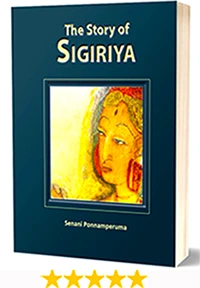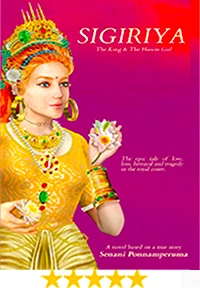Sigiriya Frescoes: Ancient Masterpieces in the Sky

Contents
What Are the Sigiriya Frescoes?
Perched high on the side of the towering Sigiriya Rock in central Sri Lanka, the Sigiriya Frescoes are among the most captivating treasures of ancient art in Asia. Painted over 1,600 years ago during the reign of King Kashyapa (477–495 AD), these stunning murals originally covered an impressive 5,600 square meters of the rock's western face, showcasing more than 500 celestial maidens in a continuous ribbon of color and elegance.
This massive mural transformed the rock into a grand canvas visible from afar across the surrounding plains. Today, however, only 19 of these exquisite paintings remain, carefully preserved in a hidden alcove about 100 meters above ground on the rock's western side. Although they represent just a fragment of the original grandeur, these surviving frescoes continue to captivate visitors and art connoisseurs, offering a rare glimpse into the artistic brilliance of Sri Lanka's ancient Sigiriya Kingdom.
What did Sigiriya Look Like with Frescoes?

Photo: Artist's impression of Sigiriya in the past
At its peak nearly 1600 years ago. The Sigiriya frescoes were an awe-inspiring sight and were part of a vast tapestry that extended in a gigantic band around the waist of the rock. This immense picture gallery of over 500 semi-naked females covered an area of approximately 5,600 sq meters. It extended from the top of the zigzag stairway at the Terraced Gardens on the southern end of the rock, to the north-eastern end, terminating at the Lion Staircase. They were a colorful and awe-inspiring sight clearly visible from all vantage points of the complex, most prominently from the grand ceremonial western entranceway.
Why were the Sigiriya Frescoes Painted?
Sigiriya served as the royal capital of King Kashyapa, who reigned from 477 to 495 AD. Due to his disfavor with the clergy and the citizens of his former capital at Anuradhapura, Kashyapa left the old capital and established a new one at Sigiriya.
Unbridled by the constraints of religion, he chose to use his kingdom's vast wealth and energy to create a lavish masterpiece for himself. Having selected this site with the massive 200-meter-high rock, Kashyapa built his vision of the mythological city of Alakamanda - the city of the gods. In Buddhist mythology, Alakamanda was said to be an exquisitely beautiful city amongst the clouds. Thus inspired, Kashyapa painted Sigiriya Rock white to appear like a cloud. But a stark white rock would have been an impressive but unattractive sight. So Kashyapa and his architects set about decorating the rock. Having fallen afoul of the clergy, Kashyapa chose to decorate his rock with a non-religious theme. What better example of beauty could he behold than the striking women who graced his court?
So the women of Kashyapa's court were depicted like Apsaras—celestial nymphs showering flowers from above on the human beings below while Kashyapa, the god-king, lived in his magnificent Sky Palace on top of a cloud.
Who are the Women in the Sigiriya Frescoes?
The rich adornments, sophisticated clothing, lifelike appearance, vibrant use of color, and the accurate rendition of facial and anatomical characteristics support the view that the artist drew his inspiration from the ladies of King Kashyapa's court — his harem. The most telling validation of this view is that they all wear a delicate three-circled tattoo around their necks (see photo).

Photo: A lady with a tattoo - Sigiriya Frescoes
The prominent but unobtrusive display of this tattoo, worn with pride, was meant to clearly identify these ladies as belonging to the king. They were ladies of the king's harem dressed in their finest. They were to be admired but not touched. For this reason, they were depicted in true form, voluptuous and desirable, but shorn of any earthly sexuality. They were not intended to be titillating. Depicted as supernatural beings, they are portrayed with flowers to shower upon humans below. They were intended to evoke a sense of wonderment and to project the opulence and grandeur of Kashyapa, the all-powerful god-king. They are a celebration of beauty.
Having lived in the king's harem we shall certainly not go outside in his absence.
Thus reflecting, they are as if stopped and are standing, looking forward.
Sigiriya Graffiti
What Artistic Style is Used?
The Sigiriya Frescoes bear some resemblance to the Gupta style of painting in the Ajanta Caves in India. Given the close proximity of the two countries and the fact that at the time in the 5th century, both shared the Buddhist faith, there is little reason to doubt that the Sigiriya Frescoes were influenced by the paintings at Ajanta. The Sigiriya Frescoes, however, are judged to be far more vibrant, fluid, and lifelike than their counterparts in the Ajanta Caves.
These paintings offer a rare glimpse of ancient Sinhala art at its zenith. The bold representation of well-formed bodies, ample bosoms and full lips are unusually provocative. They are the only open display of female sensuality depicted in Sri Lankan art. (Numerous female figures of a religious nature exist, but they follow a strictly stylized form).
These paintings are uniquely Sri Lankan in their character. They are the only surviving secular (non-religious) art from antiquity found in Sri Lanka today. The Chitrasutra, an ancient manuscript on the art of painting, notes:
The connoisseurs praise the display of light and shade.
Women like the display of ornaments.
The richness of colors appeals to common folks.
The artists, therefore, should ensure that the painting is appreciated by everyone.
How were the Sigiriya Frescoes Painted?
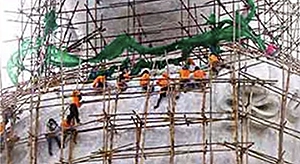
Photo: Example of how frescoes were painted
The Sigiriya frescoes are over 1,500 years old. Work on the Sigiriya murals started after the exterior wind-break wall of the Sky Palace on the summit had been completed. Tens of thousands of pieces of bamboo were transported to the site and assembled into a massive latticework of scaffolding extending from the base of the rock all the way to the summit two hundred meters above. The entire structure was held together with nothing more than rope made from coconut fiber. There were no ladders or safety rails. Access to the working platforms was by clambering up the scaffolding's bamboo cross members. All raw materials were hauled up by hand.
Stonemasons were the first to start work on the rock face. They chiseled away at the surface, creating a drip ledge. This prevented water from flowing down the natural curvature of the rock and over the area where the frescoes were to be painted.

Photo: Rope used to tie scaffolding
The plasterers followed the stonemasons. They cleaned the surface and then applied up to three layers of lime plaster. The plasterers and artists worked closely together. The plasterers prepared the surfaces, and the artists then painted on the final layer while it was still wet. Because these are fresco paintings and had to be drawn on wet plaster, the topmost surface was laid down in new sections each day.
The technique used in these paintings is called " fresco lustro". It varies slightly from the pure fresco technique in that it also contains a mild binding agent or glue. This gives the painting added durability, as clearly demonstrated by the fact that they have survived, exposed to the elements, for over 1,600 years. Each fresco was painted on a wet plaster surface consisting of two or sometimes three distinct layers. The first layer was clay plaster. The second, when present, was a clay-lime plaster. The topmost layer was a very fine lime plaster. Only red, yellow, green, and black pigments were used. The red, yellow and green colors were extracted from earth-minerals. The black pigment was charcoal black. These pigments were used because they were resistant to the alkalinity of wet plaster and were impervious to sunlight which would have quickly faded vegetable dyes. The paintbrushes were made from hair collected from the ear of a calf, the belly of a goat, the tail of a muskrat, the tail of a squirrel, the whiskers of a cat and the tips of grasses.
Early each day, the chief artist drew an outline of each fresco, on fresh wet plaster, with a fine brush dipped in red paint. These outlines were then painted in with layer upon layer of paint until the desired richness of color was attained. It was at this time that the final and most important aspect of the painting was undertaken. Known as the "opening of the eyes", only the chief artist was entrusted with this delicate ritual. It was he who breathed life into the painting by performing the final and most important detail to be painted.
Once the frescoes were completed, the rest of the surface of the rock was covered in white paint, and the scaffolding progressively dismantled, revealing a site to behold.
The Frescoes aren't Perfect

Photo: Flaws visible of Sigiriya Frescoes
The Sigiriya Frescoes, like all true frescoes, were painted quickly on wet plaster. This painting technique leaves little room for error. When applied, the paint is immediately "sucked into" the plaster. As a consequence, it is almost impossible to erase or successfully over-paint a mistake. The Sigiriya Frescoes have several such errors. For example, notice the maiden with the basket. Originally her right hand was positioned over her breast and then repositioned lower down in the final rendition.
The Sigiriya Frescoes were painted 100 meters above ground. They were never intended to be examined at closed quarters as they are today. When viewed from a reasonable distance, minor blemishes are not visible. It is also important to keep in mind that the frescoes that survive today are in a small indentation in the rock occupied only a minor position in the massive tapestry that covered the rock. Consequently, they may have received less artistic attention than the larger frescoes that were more prominently displayed. Also, keeping in mind that the frescoes were painted by artists high above the ground, working long hours, perched on flimsy bamboo scaffolding. Mistakes would inevitably have been made.
The frescoes on the left contain two errors. Firstly, the lady holding the lotus blossom has had her thumb repositioned. Secondly, the handmaiden on the right has a mistake just above her left breast. The artist originally positioned her hand in front of her breast but subsequently changed his mind and repositioned her hand elsewhere. He then covered up his mistake by painting a red blouse referred to as thanapatiya to hide his mistake.
Sigiriya Frescoes - Ancient Tourist Attraction
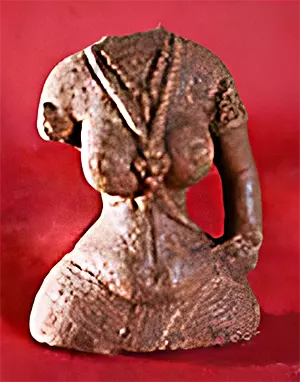
Photo: Souvenir statue depicting a fresco
Tourists have been visiting Sigiriya from as early as the 6th century, a mere hundred and fifty years after it was abandoned as a royal citadel and converted into a monastery. As the monastery started to fall into hard times, it may have supplemented its income by allowing visitors and pilgrims to see the rather titillating frescoes.
Little statues depicting a fresco have been discovered in the Boulder Gardens, which appear to be replicas of the frescoes. These trinkets for tourists were probably sold from stalls to supplement the monastery's income. This further confirms the view that Sigiriya became a novelty tourist attraction from a very early time.
Sigiriya Frescoes - Destroyed & Vandalized
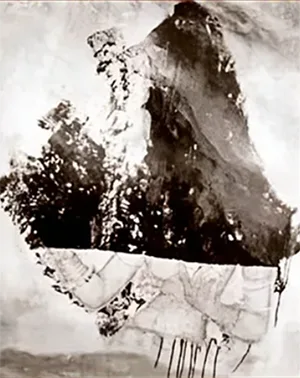
Photo: Vandalized Sigiriya fresco
There is unsubstantiated speculation that once Sigiriya was converted to a Buddhist monastery, many of its frescoes were removed, as they were seen to be too provocative for a religious establishment.
The most recent act of vandalism was committed on the night of the 13th of October 1967. Under cover of darkness, vandals snuck into the unguarded Sigiriya site and made their way up to the frescoes. There, they hacked away major parts of two of the frescoes and daubed green paint on fifteen of these priceless works of art. Some say it was the work of local shop owners angry at a plan to relocate them away from the historic site. Others suggest that it was the work of zealots with a misplaced sense of puritanism. The culprits were never apprehended. Many months of painstaking restoration work was carried out to salvage these treasures. The restoration process did, however, strip some of the vibrancy from the original colors.
Two frescoes were lost forever.... read more.
How Many Sigiriya Frescoes are there today?

Photo: Panoramic view of Sigiriya Frescoes
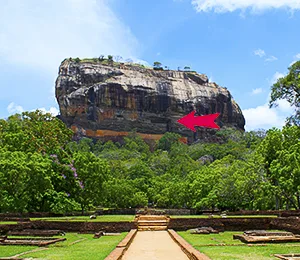
Photo: Location of frescoes on Sigiriya rock
Only nineteen Sigiriya frescoes survive today. Hundreds of these paintings were lost over the years due to environmental factors such as wind and rain and intentionally destroyed by human intervention.
Featured Books
The Story of Sigiriya: An illustrated deep dive into Sigiriya's architecture, politics, and art.
Sigiriya – A Historical Novel: Palace intrigue, betrayal, and forbidden love set in ancient Sri Lanka.
